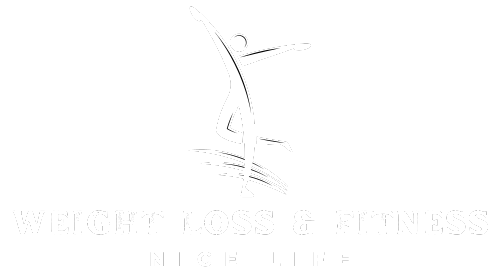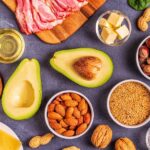Weight loss often takes center stage as a prominent goal. As individuals seek effective strategies to shed excess pounds, the concept of managing total daily fat intake to lose weight emerges as a critical consideration.
Far from a one-size-fits-all approach, understanding the nuanced role of dietary fats in weight loss entails a balanced perspective that encompasses scientific insights, individual needs, and sustainable practices.
This exploration delves into the multifaceted relationship between total daily fat intake and successful weight loss.
From the functions of dietary fats in the body to the myths surrounding “low-fat” diets, this journey will unravel the complexities of fat consumption as a key element of a comprehensive weight management strategy.
By understanding the impact of various types of fats, identifying optimal fat intake levels, and learning practical methods to incorporate healthier fats into daily meals, individuals can empower themselves to embark on a sustainable path toward achieving their weight loss objectives.
I. Understanding Total Daily Fat Intake
In the realm of nutrition and weight management, comprehending the concept of total daily fat intake to lose weight is fundamental.
A. Definition of Total Daily Fat Intake
Total daily fat intake refers to the total amount of fat consumed from food and beverages over the course of a day.
It is measured in grams and is a critical component of the broader dietary landscape. Monitoring fat intake is vital for those striving to manage their weight, as fats are a concentrated source of energy that can contribute significantly to the daily caloric intake.
Understanding how much fat is being consumed relative to overall calorie intake is key to achieving and maintaining a healthy weight.
B. Different Types of Dietary Fats
Not all fats are created equal, and their impact on health and weight management varies widely. There are three primary categories of dietary fats:
1. Saturated Fats: These fats are commonly found in animal products such as meat and dairy, as well as in some tropical oils. A diet high in saturated fats is associated with an increased risk of heart disease and should be consumed in moderation.
2. Unsaturated Fats: Unsaturated fats are further divided into monounsaturated and polyunsaturated fats. These fats are considered heart-healthy and can be found in sources like nuts, seeds, avocados, and fatty fish.
They play a role in reducing inflammation, improving lipid profiles, and supporting overall cardiovascular health.
3. Trans Fats: Trans fats are artificially created through a process called hydrogenation, and they are often found in processed and fried foods. Trans fats have been linked to an elevated risk of heart disease and should be minimized or avoided entirely.
C. Importance of Balancing Fat Consumption
Achieving a balanced fat consumption is integral to both weight management and overall health.
Fats serve several essential functions in the body, including providing a concentrated source of energy, supporting cell structure, aiding in the absorption of fat-soluble vitamins (A, D, E, and K), and contributing to satiety.
However, consuming excessive amounts of dietary fat can lead to a surplus of calories, potentially contributing to weight gain.
On the other hand, drastically reducing fat intake can result in an imbalanced diet and potential nutrient deficiencies.
Striking the right balance between fat consumption, overall calorie intake, and nutritional needs is crucial for sustainable weight loss and overall well-being.
II. Factors Influencing Total Daily Fat Intake to Lose Weight
The journey towards successful weight loss is intricate and personalized, influenced by a range of factors that shape an individual’s total daily fat intake to lose weight.
A. Individual’s Basal Metabolic Rate (BMR)
The basal metabolic rate (BMR) represents the number of calories an individual’s body requires to sustain basic functions at rest, such as breathing and maintaining body temperature.
BMR is influenced by factors such as age, gender, weight, and body composition. Since fats are a concentrated source of energy, an individual’s BMR plays a significant role in determining their ideal fat intake.
A higher BMR necessitates a higher caloric intake, and therefore, an appropriate amount of dietary fat to provide the necessary energy.
B. Daily Energy Expenditure and Physical Activity Level
The total energy expenditure (TEE) of an individual comprises BMR, thermic effect of food (calories burned during digestion), and physical activity.
Those seeking weight loss must maintain a caloric deficit, expending more calories than they consume.
Physical activity level, including both structured exercise and daily movement, greatly impacts the daily energy expenditure.
The balance between caloric intake and energy expenditure, along with proper fat intake, is vital for sustainable weight loss.
C. Macronutrient Distribution and Diet Composition
The distribution of macronutrients—carbohydrates, proteins, and fats—in the diet significantly affects weight loss outcomes.
While fats are calorie-dense, they also contribute to satiety and energy. The ratio of macronutrients influences hunger, metabolism, and the body’s response to insulin.
A well-balanced diet that includes a moderate amount of healthy fats alongside appropriate levels of protein and carbohydrates can promote weight loss while providing essential nutrients.
Finding the right balance among these factors is crucial for tailoring an effective approach to total daily fat intake to lose weight.
This requires careful consideration of an individual’s unique characteristics, lifestyle, and goals.
III. Establishing a Caloric Deficit
A fundamental principle in the realm of weight loss is the establishment of a caloric deficit.
A. Explanation of Caloric Deficit for Weight Loss
At its core, a caloric deficit occurs when an individual consumes fewer calories than their body expends over a given period.
This creates an energy imbalance that prompts the body to utilize stored energy reserves, primarily in the form of body fat, to meet its energy demands.
The resulting energy shortfall forces the body to tap into its fat stores for fuel, leading to weight loss over time.
B. Relationship Between Calorie Intake and Weight Loss
The principle of “energy in, energy out” underscores the relationship between calorie intake and weight loss.
When the calories consumed through food and beverages are less than the calories expended through metabolic processes and physical activity, the body turns to its energy reserves to bridge the gap.
This process is what drives weight loss. However, it’s crucial to strike a balance—excessive caloric restriction can lead to nutrient deficiencies and metabolic slowdown.
C. Calculating the Appropriate Caloric Deficit for Fat Loss
Determining the optimal caloric deficit requires a delicate approach. Too aggressive a deficit may trigger muscle loss and hinder metabolism, while too conservative a deficit might slow down weight loss progress.
To calculate an appropriate caloric deficit, one can follow these steps:
1. Estimate Basal Metabolic Rate (BMR): Use equations like the Harris-Benedict equation to estimate the calories your body needs at rest.
2. Factor in Physical Activity: Multiply your BMR by an activity factor that reflects your level of physical activity.
3. Create a Moderate Deficit: Aim for a caloric deficit of around 300 to 500 calories per day. This deficit is sustainable and promotes gradual fat loss.
4. Monitor and Adjust: Regularly assess progress and adjust caloric intake as needed. As weight changes, so do energy requirements.
It’s important to note that individual responses to caloric deficits can vary based on factors like genetics, hormonal balance, and metabolism.
Consulting with a healthcare professional or registered dietitian can provide personalized guidance in determining the most appropriate caloric deficit for your weight loss goals.
IV. Role of Dietary Fat in Weight Loss
Dietary fat, often perceived as a culprit in weight gain, actually plays a multifaceted role in the context of weight loss.
A. Functions of Dietary Fat in the Body
Dietary fat serves as more than just a source of energy. It plays several vital roles in the body:
1. Satiety: Fats are slow to digest and help you feel fuller for longer, aiding in appetite control and reducing overeating.
2. Nutrient Absorption: Fat is necessary for the absorption of fat-soluble vitamins (A, D, E, and K) that contribute to various bodily functions.
3. Hormone Regulation: Certain fats are precursors to hormones that influence metabolism, hunger, and overall health.
4. Cell Structure: Fats are integral components of cell membranes, ensuring proper cellular function.
5. Insulation and Protection: Adipose tissue (body fat) provides insulation and protection for vital organs.
Recognizing these functions underscores the importance of including adequate dietary fat in a balanced weight loss plan.
B. Myth of “Low-Fat” Diets for Weight Loss
The notion that eliminating or severely restricting dietary fats is a guaranteed pathway to weight loss is an oversimplification.
“Low-fat” diets gained popularity in the past, driven by the belief that reducing fat intake would inherently lead to shedding excess pounds.
However, this approach often led to unintended consequences, such as an increased reliance on refined carbohydrates and added sugars.
These changes could negatively impact insulin sensitivity, hunger regulation, and overall nutrient intake.
C. Optimal Amount of Dietary Fat for Sustainable Weight Loss
Rather than aiming for a “fat-free” approach, a more balanced strategy is to incorporate the right types and amounts of fats into the diet:
1. Focus on Healthy Fats: Prioritize sources of unsaturated fats, including avocados, nuts, seeds, olive oil, and fatty fish. These fats offer numerous health benefits without excessive calorie density.
2. Mind Portion Control: While fats are beneficial, they are calorie-dense. Monitoring portion sizes is crucial to avoid overconsumption.
3. Create a Caloric Deficit: As explored in previous sections, a moderate caloric deficit combined with appropriate fat intake supports weight loss while maintaining essential bodily functions.
Balancing the inclusion of healthy fats within a calorie-controlled diet can lead to more sustainable weight loss outcomes.
Striking the right balance allows for better adherence, optimal nutrient intake, and a higher likelihood of maintaining weight loss in the long run.
V. Tips for Managing Total Daily Fat Intake to Lose Weight
Effectively managing total daily fat intake is a pivotal aspect of successful weight loss.
A. Choosing Healthier Fat Sources
1. Embrace Unsaturated Fats: Opt for sources rich in monounsaturated and polyunsaturated fats, such as avocados, nuts, seeds, and fatty fish. These fats provide essential nutrients and contribute to heart health.
2. Use Cooking Oils Wisely: Select healthier cooking oils like olive oil, avocado oil, or canola oil. These oils offer a better balance of unsaturated fats and are ideal for various cooking methods.
3. Limit Saturated and Trans Fats: Minimize intake of foods high in saturated and trans fats, such as fried foods, processed snacks, and fatty cuts of meat.
B. Portion Control and Mindful Eating
1. Be Mindful of Portions: Keep track of portion sizes to avoid unintentional overconsumption of fats and calories. Using measuring tools can help develop a better sense of appropriate portion sizes.
2. Eat Slowly and Mindfully: Eating slowly allows your body to recognize satiety cues, preventing overeating. Focus on the sensory experience of eating to enhance satisfaction.
3. Avoid Distractions: Eating without distractions (like screens or work) allows you to fully engage with your meal and be more attuned to hunger and fullness signals.
C. Reading Food Labels to Identify Hidden Fats
1. Check Total Fat Content: Pay attention to the “Total Fat” section on food labels. This provides a snapshot of the fat content per serving.
2. Differentiate Between Types of Fats: Look for the breakdown of saturated, unsaturated, and trans fats. Aim for products with higher unsaturated fat content and minimal trans fats.
3. Serving Sizes: Be aware of serving sizes listed on labels. The nutritional information might apply to a smaller portion than you intend to consume.
4. Ingredients List: Review the ingredients list for sources of hidden fats, such as hydrogenated oils and palm oil, which can indicate the presence of unhealthy trans fats.
By integrating these tips into your dietary approach, you can navigate the realm of fats with confidence, optimizing your choices to align with your weight loss goals.
VI. Meal Planning and Total Daily Fat Intake to Lose Weight
Strategic meal planning plays a pivotal role in managing total daily fat intake to lose weight while working towards weight loss goals.
A. Incorporating Lean Proteins and Whole Foods
1. Choose Lean Proteins: Opt for lean protein sources like poultry, fish, lean cuts of meat, tofu, and legumes. These options provide essential amino acids without excessive fat content.
2. Prioritize Whole Foods: Embrace a diet rich in whole foods such as fruits, vegetables, whole grains, and nuts. Whole foods offer a plethora of nutrients and fiber, enhancing overall health and promoting satiety.
B. Meal Prepping for Better Fat Intake Control
1. Plan Balanced Meals: Design meals that combine lean proteins, healthy fats, and complex carbohydrates. This balance provides sustained energy and promotes feelings of fullness.
2. Prepare in Advance: Meal prepping allows you to control portion sizes and choose nutrient-dense ingredients. This practice also reduces the likelihood of impulsive, less healthy food choices.
C. Creating Balanced Meals for Sustained Energy and Satiety
1. Include Healthy Fats: Add sources of healthy fats to your meals, such as avocados, nuts, seeds, and olive oil. These fats contribute to satiety and a more satisfying eating experience.
2. Incorporate Fiber: Integrate fiber-rich foods like whole grains, vegetables, and legumes. Fiber promotes digestive health and helps manage appetite by extending the feeling of fullness.
3. Monitor Portion Sizes: Be mindful of portion sizes for all components of your meal. Balancing the macronutrients appropriately ensures that you are meeting your nutritional needs without overdoing any specific nutrient.
Strategically planning your meals allows you to manage your total daily fat intake to lose weight without feeling deprived or overwhelmed.
VII. Monitoring and Adjusting Fat Intake
Effective weight management requires vigilant monitoring of fat intake and the ability to make necessary adjustments.
A. Tracking Fat Intake Using Apps or Journals
1. Utilize Tracking Apps: Mobile apps and online tools can simplify the process of monitoring your dietary intake, including fats. These apps often provide nutritional information for various foods and help you visualize your daily intake.
2. Keep a Food Journal: Keeping a physical or digital food journal can help you become more aware of your eating habits, including the types and amounts of fats you consume.
B. Recognizing Signs of Excessive or Inadequate Fat Intake
1. Excessive Fat Intake: Signs of consuming too much dietary fat might include feeling overly full or sluggish, gaining weight rapidly, or experiencing digestive discomfort. High-fat diets can lead to excessive calorie intake, hindering weight loss efforts.
2. Inadequate Fat Intake: Insufficient fat consumption may lead to feelings of persistent hunger, reduced energy levels, dry skin, and difficulty absorbing fat-soluble vitamins.
C. Making Gradual Adjustments Based on Progress
1. Track Your Progress: Regularly assess your weight loss progress and overall well-being. This involves monitoring changes in body weight, energy levels, physical performance, and how you feel after meals.
2. Adjustments for Sustainability: If progress stalls or you encounter undesirable effects, consider making gradual adjustments to your fat intake. Avoid drastic changes and instead focus on sustainable modifications.
3. Consult with Professionals: If you’re unsure about how to adjust your fat intake, seek guidance from registered dietitians or healthcare professionals. They can offer tailored recommendations based on your individual needs and goals.
Monitoring and adjusting your fat intake as needed is a dynamic process that allows you to fine-tune your approach to weight loss.
VIII. Potential Pitfalls and Challenges
Embarking on a weight loss journey involves navigating potential pitfalls and challenges that can impact the effectiveness and sustainability of your approach.
A. Overemphasis on Cutting All Fats
1. Dietary Fat as the Enemy: Fearing fats and striving to eliminate them entirely can lead to imbalanced diets. Certain fats, especially healthy unsaturated fats, are essential for overall health and well-being.
2. Inadequate Nutrient Intake: Excessive restriction of fats can lead to reduced intake of essential fat-soluble vitamins and essential fatty acids. This can negatively impact various bodily functions.
B. Ignoring the Importance of Other Nutrients
1. Balanced Nutrition: Focusing solely on fat intake may result in neglecting other vital nutrients, such as proteins, carbohydrates, vitamins, and minerals. A well-rounded diet promotes overall health.
2. Macronutrient Balance: Neglecting the balance of macronutrients can lead to energy fluctuations, mood swings, and difficulties in maintaining a sustainable eating plan.
C. Psychological and Emotional Aspects of Dietary Changes
1. All-or-Nothing Mentality: Adopting an extreme approach can lead to feelings of deprivation and frustration. These emotions may ultimately undermine adherence to your chosen dietary plan.
2. Emotional Eating: Stress, emotions, and social situations can influence eating habits. Recognizing and addressing emotional triggers is crucial for a successful weight loss journey.
3. Lifestyle Integration: Strive to create a dietary plan that aligns with your lifestyle and preferences. Making gradual, sustainable changes is often more effective than drastic, short-term measures.
Navigating these potential pitfalls involves cultivating a balanced and holistic perspective on dietary changes.
It’s important to focus on a well-rounded approach that addresses the interplay of macronutrients, considers psychological well-being, and promotes sustainable habits.
IX. Seeking Professional Guidance
Embarking on a weight loss journey can be complex, and seeking professional guidance ensures that your approach is tailored to your individual needs and health considerations.
A. Consulting with a Registered Dietitian or Nutritionist
1. Expert Guidance: Registered dietitians and nutritionists are trained professionals who possess in-depth knowledge of nutrition, weight management, and health. Their expertise can guide you through the complexities of dietary choices.
2. Individualized Assessment: Professionals can conduct a thorough assessment of your dietary habits, lifestyle, and health status to develop a personalized plan that aligns with your goals.
B. Tailoring Fat Intake Recommendations to Individual Needs
1. Customized Approach: Every individual’s nutritional needs are unique. A professional can help determine the optimal amount and types of fats that suit your metabolism, activity level, and preferences.
2. Balancing with Other Nutrients: Professionals can advise on how to balance fat intake with carbohydrates, proteins, and other nutrients to achieve a comprehensive dietary plan.
C. Addressing Health Conditions or Specific Dietary Requirements
1. Medical Considerations: Health conditions such as diabetes, cardiovascular issues, or allergies may impact your dietary choices. Professionals can tailor your plan to accommodate these factors.
2. Sustainability and Longevity: Professionals can guide you toward a sustainable approach that not only promotes weight loss but also maintains your health in the long term.
Seeking professional guidance not only provides evidence-based recommendations but also empowers you with knowledge to make informed decisions.
X. Conclusion
In the pursuit of weight loss, understanding the role of total daily fat intake to lose weight is essential for achieving effective and sustainable results.
This comprehensive journey through the intricacies of fat intake and its connection to weight management has highlighted key considerations, strategies, and principles.
As we conclude, let’s recap the key points and emphasize the importance of personalized approaches to fat intake for optimal outcomes.
A. Recap of Key Points About Total Daily Fat Intake and Weight Loss
- Weight loss involves creating a caloric deficit, expending more energy than consumed.
- Dietary fat serves multiple roles, including energy supply, nutrient absorption, and hormone regulation.
- Differentiating between types of fats—saturated, unsaturated, and trans—is crucial for health.
- Balancing fat intake with other macronutrients supports sustainable weight loss.
- Healthy fats contribute to satiety, nutrient absorption, and overall well-being.
B. Emphasis on Personalized Approaches to Fat Intake
- Every individual’s weight loss journey is unique, influenced by factors like metabolism, activity level, and health status.
- Personalized guidance from registered dietitians or nutritionists ensures that your fat intake aligns with your specific needs.
- A balanced and individualized approach to fat consumption promotes both short-term weight loss and long-term health.
In your pursuit of improved health, remember that achieving sustainable weight loss involves more than just restricting fat intake—it’s about making informed choices, balancing macronutrients, and considering your overall well-being.













No Comments